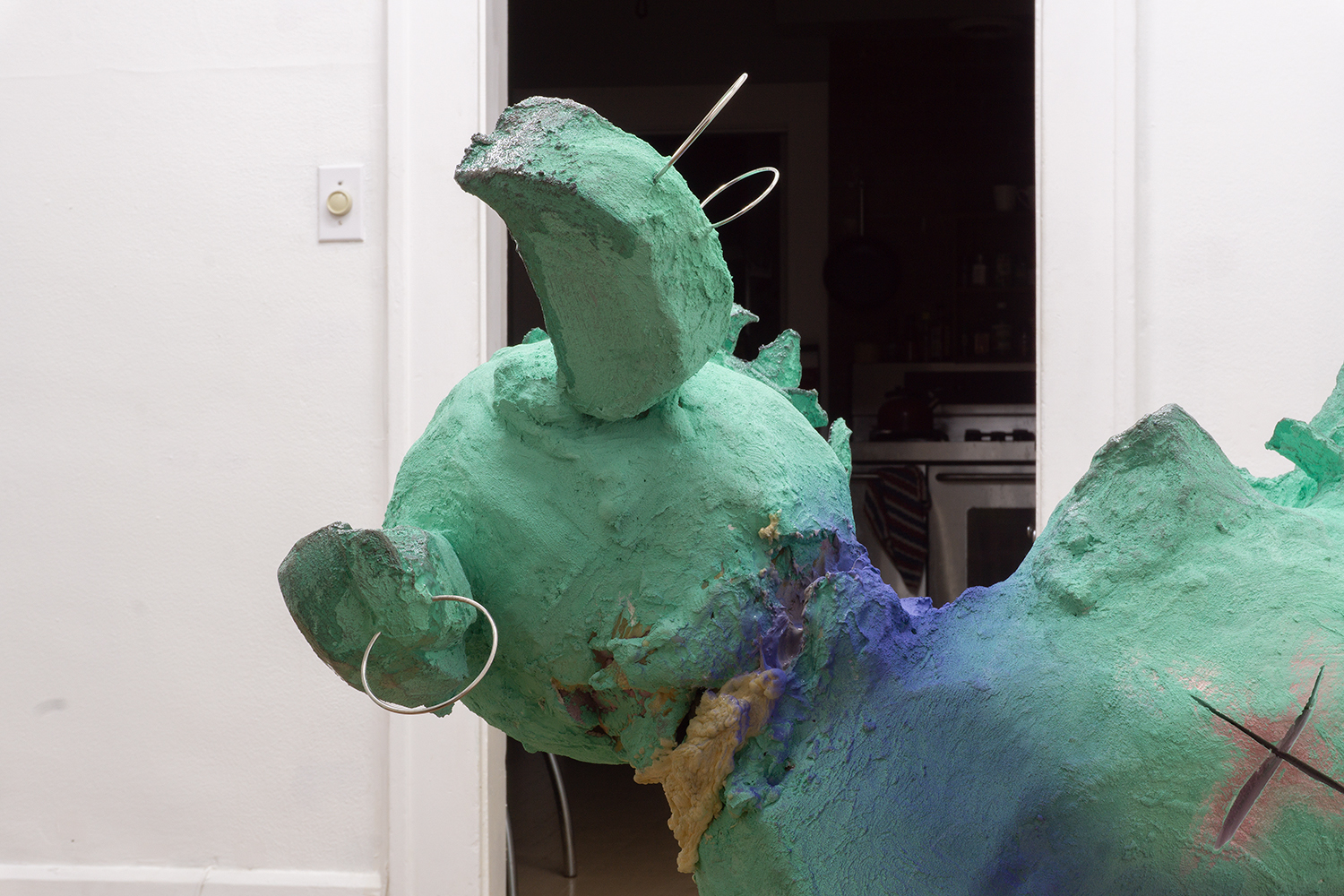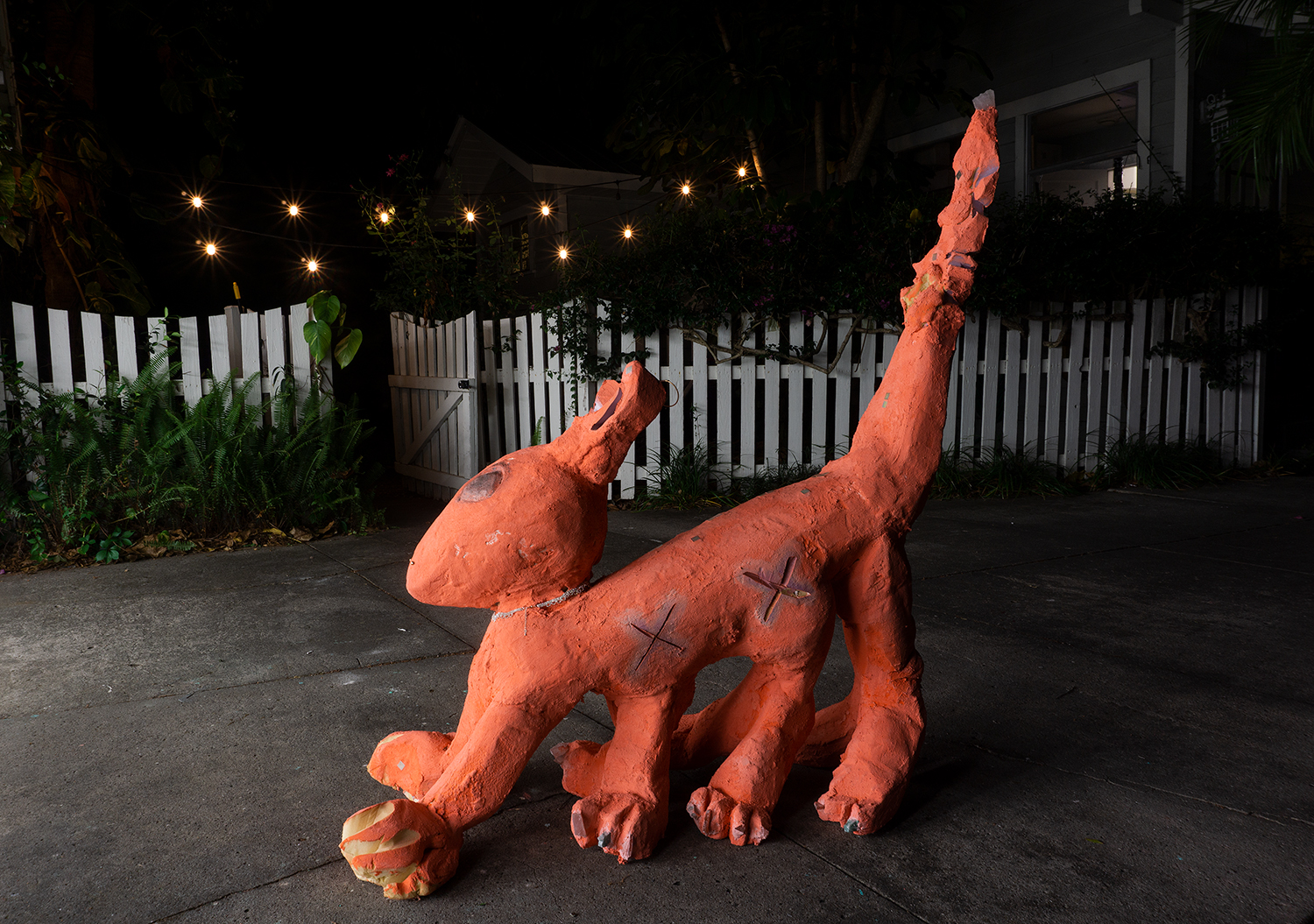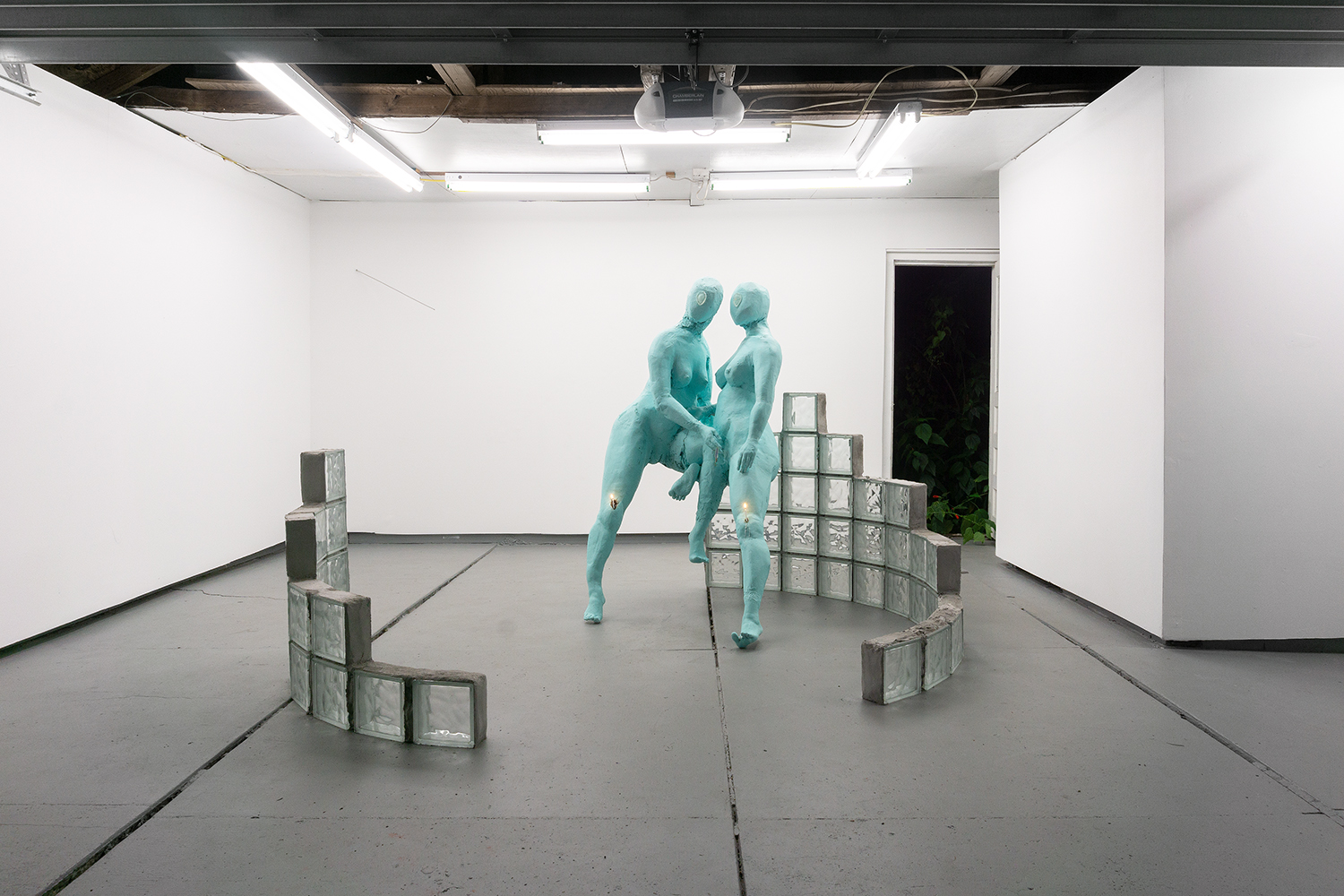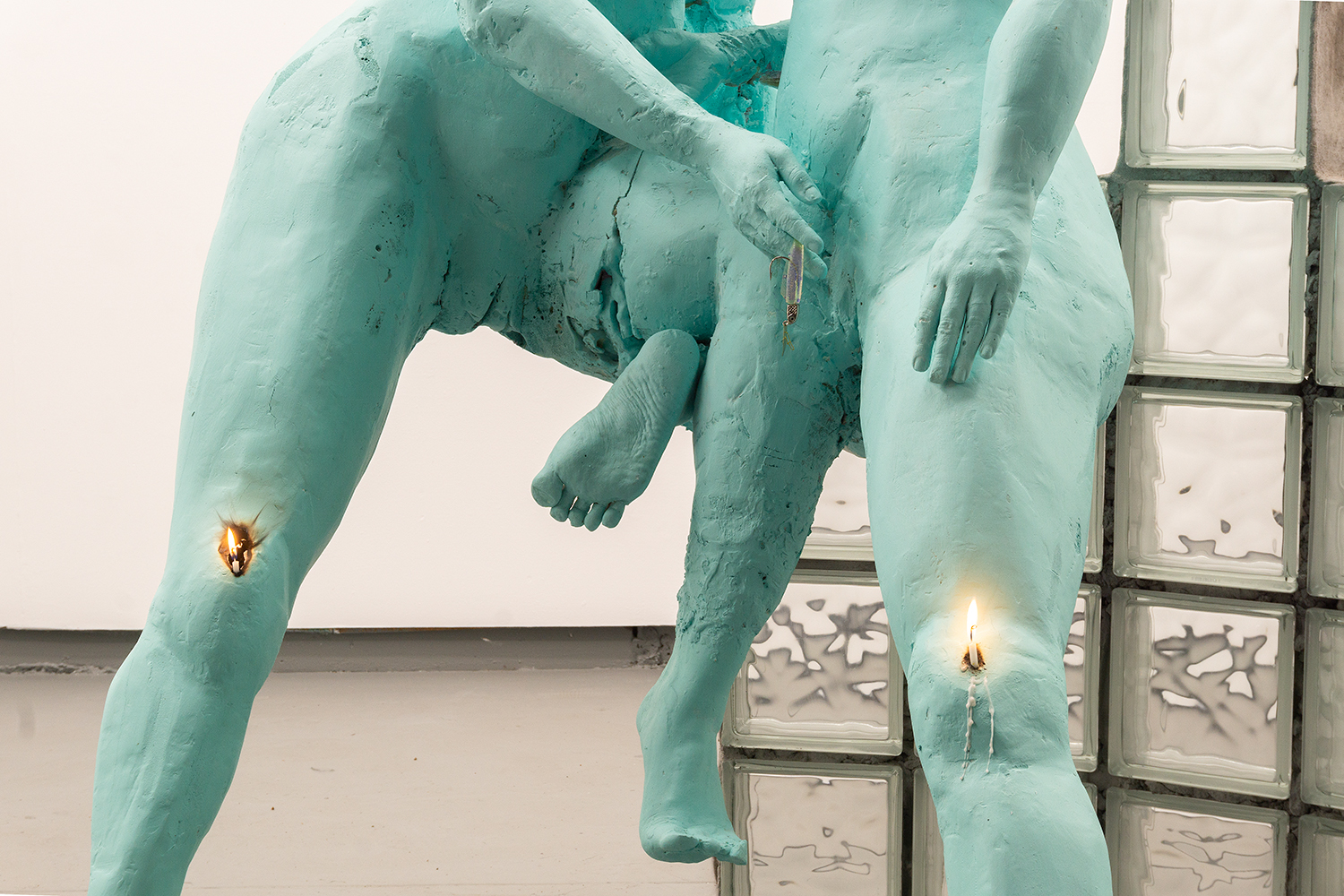d_r_e_a_m_s_e_e_n__ii
coco hunday

Byron
54”x40”x50”
extruded polystyrene, urethane rigid pour foam, joint compound, bondo, gesso, grout, ink, jb minute weld, gorilla super glue, acrylic, styrofoam, jade, quartz, earrings, binder ring, matte spray paint, resin, opal, black opal, pigment,
2020









40”x30”x54”
extruded polystyrene, urethane rigid pour foam, joint compound, bondo, grout, gesso, ink, jb minute weld, gorilla super glue, acrylic, styrofoam, jade, rose quartz, glass shard, earrings, cubic zircona necklace, glass blocks, pigment, iridescent tile
2020











Ponce’s work is about pleasure and pleasures.
To seek pleasure is a potent form of critique and dissent, it leaves many dated binaries and dog-eared, critical frameworks behind.
To find pleasures is to detach from a horizon that has lost its usefulness. Untethered and disembodied can become a default space, bodying and orientation can be temporary, fluid, generous acts of pleasure and exchange, upended at a whim, folding toward multiple futures.
There is a powerful generational shift happening in making and attitude that is harder to critique and easier to believe in.
-jason lazarus, january 2020
https://vimeo.com/402648348
`d_r_e_a_m_s_e_e_n__ii´ by Libbi Ponce from Off Site Project on Vimeo.
゚*.。.・゜゚・*゚*.。.・゜゚・*
Libbi Ponce in conversation with Off Site Project
Pita Arreola: Coco Hunday is a unique exhibition space that shifts the audience away from the classic white cube space. Your show especially embraces its properties, distributing work across different parts of the house. What was your approach to the space and the various characteristics it embodies?
Libbi Ponce: Here in Tampa, I wouldn’t say there are too many white cube galleries. What seems to be a bit more prominent, with a large influx of art professors and professionals from Chicago and SAIC, where apartment galleries are very common, these folks decided to start their own galleries in garages or houses to help foster Tampa’s art community. Even then, I think there’s an effort to make things a lot cleaner. So, spaces, especially the garage, have a finished look.
Elliott Burns: That’s interesting.
LP: Originally, the layout for this show had a formula to it. Which would have been each of the main spaces, the dining room and garage, having a glass block separator and a dog before the glass, that the viewer would encounter first, and behind there would be a couple. However, I felt these things commanded a bit too much attention and they would be competing too much with each other.
After a while, I realised that the formula was too predictable and I wanted to earn it. So right now, it’s got in the dining room area, one glass block structure and also a dog here called Byron. Then in the garage, there is another dog before you enter and a second set of glass block separators, in a semicircle, and a couple figure in there. Then past that, going on the patio up the stairs, there’s another formation, a couple, but it reveals itself a lot more slowly. It’s a more intimate space being up on the balcony.
About these dogs, specifically their placement in relation to where they originated from, which is a rug at the entrance of my aunt’s house in Toronto. They have the anatomy of a dog that has four legs, but, each leg has two feet, which have toes or little finger paws. They came from an entrance, right. So, I thought they should coincide by being at the entrance of the property.
EB: In this case, you haven’t employed projection to recreate a domestic scene, this exhibition actually pulls back and lets the space speak for itself, it’s much more minimal than previous shows.
LP: I had thought about using projection, or maybe even using some gels for the lights, because it is something I’m used to working with, but I also felt that in a way it’s a safety blanket. I wanted to challenge myself and see how the work worked without that. I did try out some projection onto the glass blocks beforehand, however, I wasn’t compelled, it didn’t seem new to me. This is really a sculpture show, I’ve been embracing that recently.
PA: There’s a suggestion of digitality in the aesthetics and way objects are positioned in the show. From the textual glitches in the sculptural surfaces, to the transparency of the glass blocks. Do you feel digital spaces as influencing and informing your approach to analogue materials?
LP: For sure, I am borrowing aesthetics from a digital realm. Those glass blocks for example, I think they mimic the way that in Maya and other CAD programmes you go about making models, starting off with block and squares, then just refining everything. It’s very much similar. That’s why I felt it came a little bit more naturally when I was working with them, I understood how to do it in a different way because I had done it before.
And having done 360° video, I’ve thought a lot about how this video infrastructure is projected within a head mounted display and fields of view that capture and mimic human perception. I’m interested in the spaces created by this technology, for example, with the lower grade 360° cameras such as the Ricoh Theta S a tube is produced, with a black hole at the top and bottom. Or when viewing different VR pieces, whenever there’s a physical change and the technology tries to recalibrate itself to the viewer’s physical motion, then this grid often appears, just making sure that it’s correctly mimicking your perception and where you are within the space too. That’s where these glass blocks come in.
Thinking about video games and first-person shooters, Halo 5 specifically, I link Cortana with these blue figures, and this aluminium rod that comes out the wall here, is aimed right at them. So there’s a very loose narrative being borrowed.
EB: I think it leads to a vapourwave aesthetic, the colour palette feels informed by that visual culture, which has links to video games, but also interestingly is positioned in relation to the Miami or Florida and the iconography of that region.
LP: As far as colours, some of them were already pre-determined. For example, the dogs, their route of inspiration was the rug, one was green on the rug and then there was an orange-red dog in the rug too. The figures in the garage were inspired by part of a painting I saw, which was in blue contour paint, so I decided to keep it the same sort of blue. Whilst the figures upstairs, the foam naturally comes in these odd colours, baby blue or lavender or a light yellow.
I grew up in Florida, beach colours are always around, that’s the optimal decor, subconsciously it translates into my work. I really gravitate towards some of these colours, I incorporate them into my wardrobe and everything else.
PA: We’ve been discussing aesthetics, but one of the aspects we’ve seen from your previous work is the influence of your heritage, part of this body of work seems influenced by Meso American graphic elements. How do you see that heritage informing the work conceptually or ethically?
LP: Conceptually, it’s definitely back there. In a way I feel I have permission to be looking into this because of my family’s heritage. I really admire the abstract and geometric forms that were created, I’ve been around ceramics potteries or ceramic replicas growing up. Maybe a year and a half ago, I got interested in this one specific dog figurine, the way that the form was made, the body of the animal was captured in an abstract style and I was like “oh that’s taking so much creativity liberty”.
PA: They have this mysticism or guardian quality, dogs have a very strong relationship with more mystical concepts in Latin America, you put them in altars and use them for rituals. The fact they have these quarts and jewellery makes them more ritualistic.
EB: It conveys value, right? Precious stones and precious materials. It’s like having an elaborately made headdress or dog collar.
PA: Quite magical with all the elements.
LP: I hadn’t thought about it like that. Thinking about the ethics, there are indigenous populations and artists, I did not necessarily grow up like that. But, when I would ask my great grandmother about it, she very adamantly would say “Oh no, we’re Mestizo” and still its very highly stigmatized too. It’s something I’m questioning and trying to work through.
EB: I guess the jewellery comes into the way we typically understand cultural ancestry, we see it in a museum and we see these rarefied pieces of culture that have been collected and said by a curator to have previous value.
PA: It not only reminds me of Latin American cultures but also Egyptian and Mesopotamic cultures and how they translate these animals into objects.
LP: Yeah, how a lot of these cultures will have anthropomorphic figures too, anthropomorphic figures but also different combinations of them, they’re not always combined with humans.
EB: Funnily, there’s something slightly extra-terrestrial too. Something that pushes what a dog is to the limits of how the pictographic form can work. We’ve spoken before about them having a slight nod to Lilo and Stitch.
LP: I have always been really interested in Sci-Fi, although, I don’t think I consume as much as I would like to. With these alien figures, it’s combining two references and these different characteristic features that are not of the right now. It’s not what we know contemporaneously, within our natural world.
EB: In Fernanda (2019) there’s a section of footage where you see effigies from Ecuador being burnt in the street. Those sculptures are created from a very 2by4, chicken wire, papier mache materiality. We wanted to ask whether those reference points have been an influence in the work you’re producing now or the way you’re going around sculpting?
LP: I would say definitely it’s helped propel that style or method of making sculpture. It was December 2018, January 2019 that I went over to Ecuador and shot Fernanda and shot the footage for that and saw how those effigies are built. At first, I didn’t realise why I wanted to have candles on the knees of these sculptures, especially when I produced the first iteration in June in Connecticut. But now looking back on it and thinking about Fernanda and having these birthday candles lit during the opening makes a lot of sense. Very similar to how the fireworks are sunk into Año Nuevo hosts. And are caught on first and basically explode. So, this is a homage to that ceremony and tradition. But I don’t want the whole thing to explode, only parts of it that can be rebuilt.
EB: One question we had about the thematic of d_r_e_a_m_s_e_e_n__ii, you talk about pleasure to be a critique or form of dissent. What are you critiquing?
LP: Jason [Lazarus] produced that excerpt for the show in response to our discussions. The work I’m making is not necessarily a critique, but the production of my work and why I work is for my own pleasure, so I guess it’s more of a second-hand critique, by not even acknowledging those issues it’s like saying that they’re not overwhelming. Pleasure to allow myself to have the freedom to imagine. I remember seeing this show of Patricia Cronin at the Tampa Museum recently, it was very PG, they’re just lying down next to each other and I thought “this could be a little more explicit.” I just like to be able to live very confidently in that way.
EB: You’re creating space for something better.
LP: I’m a very optimistic person, I don’t know if focusing too much on something is going to necessarily help. It could really hinder your actions and ability to function. I’m very easily subscribable to utopic thoughts. A space where these dogs and couples can come together in a way that only happens in dreams.
PA: Dreams somehow remind me of the poetics of video games, where you can fly and there’s a disconnect from what’s happening in the outside world and then the aesthetics are constantly challenging the possibility of the terrain.
LP: This piece, the couples in the garage, has really video game physics, because it shouldn’t be able to just balance on the tip of the toes. No one could pose like that for too long.
EB: Presumably its light, so there’s a disjunction between the fact it looks like two people in terms of weight, but the materiality is much lighter. Press spacebar in Second Life and you can float up in the air logic.
LP: They are pretty light, I can pick them up. That’s another reason I started working with foam, because I wanted to make stuff that I could move around by myself.
—
Off Site Project is a curatorial practice founded by Pita Arreola-Burns and Elliott Burns in 2017. Primarily based online Off Site Project runs a regular gallery programme of homepage exhibitions; bi-monthly downloadable ZIP shows; and quarterly residency based on Google Maps. To date the gallery has worked with over one hundred and twenty artists, designers, creatives and curators, producing over forty exhibitions, hosting ten residencies and being invited to speak host and speak at panels at Central Saint Martins, Modern Art Oxford and Somerset House Studios.
Through its exhibition programme Off Site Project has explored issues pertaining to our increasingly networked, digitised world, from neoliberal post-colonialism in Latin America to the increasingly monetised wellness industry, around societal effects of the internet such as the blurring of IRL and URL spaces to the prevalence of conspiratorial thinking, as well as the creative identity of AI minds and our ability to inhabit multiple realities through avatar creations.
Pita Arreola-Burns is a Mexican independent curator and designer who has recently produced exhibitions for the Austrian Cultural Forum and University of the Arts London. She has a background of work experience including acting as Associate Director of Mexico based Anonymous Gallery and as a Cultural Senior PR and Communications Executive at Another Company, a leading Mexico City-based PR firm, creating and managing campaigns for clients such as Phillips Auction House and Estancia FEMSA-Casa Luis Barragán.
Elliott Burns is an Associate Lecturer within the Culture & Enterprise department at Central Saint Martins and a freelance curator, in 2018 he produced an exhibition for the Centre for Investigative Journalism to coincide with their bi-annular Logan Symposium. He has a background in art production having worked for Unlimited Productions helping produce the first Art Night event in 2016 and has gained experience with Studio Voltaire, UNION Gallery and White Cube.